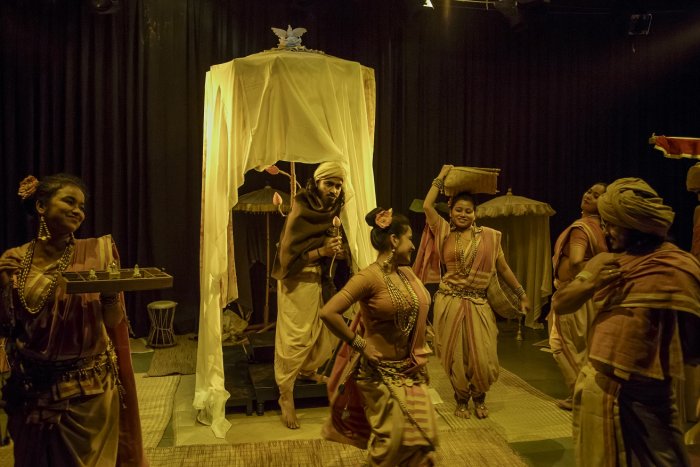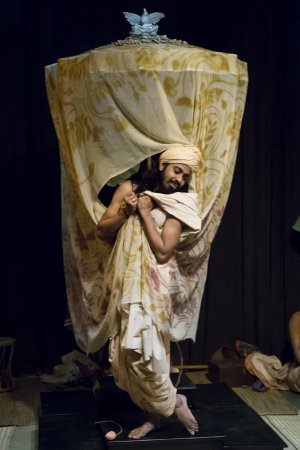
|   |

|   |
 e-mail: sunilkothari1933@gmail.com Bhaanotsav: Reconstructing of Rupaka and Uparupaka Photos: Amarendra Nath Dutta March 12, 2020 Established in 2013 by Kathakali exponent and Sanskrit scholar, musician, musicologist, actor, director Piyal Bhattacharya, Chidakasha Kalalaya, Kolkata's aim is to undertake research and practice of Bharata's Natyasastra as prayoga, presentation, reconstructing of Rupakas, which are Rasatmaka, and Uparupakas which are Bhavatmaka. Following various elements of Natyasastra, the recreation of Bhana as Rupaka and Bhanika as Uparupaka by Piyal has further opened up a new chapter in the field of classical theatre, drama and dance-dramas. Devoting his entire life to the study of Natyasastra, the music as referred to in Natyasastra, learning it from classical musicians, within India and abroad in terms of pan Indian approach, recreating instruments as mentioned in Natyasastra, like veena and harp, Piyal has taken a journey which indeed is not an easy one to grasp. It expects of the spectator also to have background of Natyasastra, knowledge of Sanskrit and also Pali, Prakrit and other allied languages - a tall order. In 2013, Piyal staged Bhanika at National School of Drama, New Delhi, which generated interest amongst scholars, directors, dancers, critics. He has been active all these years gathering like-minded actors, dancers who are willing to join him in this journey. With meager financial support but with lot of enthusiasm they have envisioned a form of Marga Natya. The Bhaanotsav under review is the first one which is based upon the monologues. Bhana, Vithi, Prakarana, and Prahasan are the types of Rupaka that were employed as a tool to educate the society in which exist social evils. The plot Kathavastu of the Rupaka is creative. In Bhana, an actor renders dialogues, enacts various characters. They may extend to fourteen characters. Thus, in Bhana the actor received rigorous training of acting and also fluidity to move into different characters. Another addition to this festival was reconstruction of Uparupaka, minor dramatic form that developed in the medieval period. Unlike Bhana, this type was employed to propagate spiritual awareness and elevate the spiritual consciousness of the society. In Nataka, there is a character of Sutradhara, a narrator. Similarly, in Bhana a character known as Vita belonging to the middle stratum of the society, as a narrator exposes the human follies, especially sexual hypocrisy in the respectable society. Verbal dialogue (Bharati vritti) forms the core of Bhana and Kaishiki vritti imparts a subtle aesthetic sense. Shringara, amorous love, and veera rasa are mainly evoked in this mode of performance. Vita helps the romantic character in his romantic aspirations. He acts as a messenger between a Ganika, courtesan and a Nagarik. He is an improverished person who partly knows some of the performing arts. He is an expert manager of a brothel. He is a good orator and efficient organizer of brothels. He cherishes the romantic affairs of the others which he expresses with his actions, utterances and attire. According to his caste, the region he belongs to, he is shown as authentic character with help of location, attire and language.  A scene from Padma Prabhrutikam The Rupaka, the play Padma Prabhrutikam (Lotus Consent) is set in the city of Ujjain, during the spring. The play unfurls with the journey of a messenger, Vita, named Samvatsara of Muladeva, king of Pataliputra. He carries a token of love, Prabhrutaka, a lotus in his hand. Muladeva in spite of a happy alliance with his wife Devadutta falls in love with his sister-in-law Devasena. Samvatsara carries a lotus as a sign of Muladeva's offering of passion to be given to Devasena. Samvatsara starts his journey in the city of Ujjain with invocation to the guardian of the city Mahakala, the personified cosmic time. He explains the content of the play in a nutshell. He comes across a galore of interesting characters. His witty vernal expressions keep the audience enthralled. He encounters a visitor to the brothel where at the entrance he finds the owner of the brothel, who demands money to enjoy sex with the prostitutes. He gives the money which she does not find enough. He tries to go in but he is driven out and falls on the floor, his headgear rolling all over the street and the onlookers laugh at him. He covers his head and runs away to the giggle of the prostitutes. Then Vita comes across a Buddhist Bhikshu, covering his face in saffron cloth and confronts the Vita, who questions him about his identity. To each reply the Vita makes fun of him taunting him that the way to Niravana is not to the road leading to brothel. Exposed, the Buddhist Bhikshu runs away. Through laughter and wit, the audience is conveyed the message from old stage actor that his dharma as an actor is to perform and entertain others by enlightening them, which is ultimate Nata Dharma. Thus, through a light hearted and funny presentation the play actually engages the audience in a serious, social and psychological subject. Sayak Mitra, the actor performing the role of Sutradhara, Vita, carries the entire burden of the play on his ability to act, recite, wear expressions, wit and sarcasm and entertains the audience. Sayak is well versed in various languages and has written the script and also assisted in composing music. The Natya Kutapa consists of seven female actors /dancers, and five male actors, musicians, set designer. They are seated in semicircle with instruments, harp, eka tantry veena, drums, cymbals and so on. The chorus is another feature of the play. The umbrella covered with cloth, from Manipur, lit up with exquisite lighting provides excellent visuals. The umbrellas are draped in slightly off saffron colour. In the centre is a creeper which has lotuses and that is suggestive of the name of the play Padma Prabhrutikam. The female dancers sing, giggle, move with sinuous gestures, and suggest the ways prostitutes act. They are all versatile actors/dancers.  Sayak Mitra as Vita Piyal as artistic director has seen to various aspects of stage, arrangement of wooden blocks which often Vita rearranges to show different streets. The visuals are stunning and despite the proximity of the sets and actors, it evokes expected ambience. The light design by Soumen Chakraborty is a highlight of the play. The costumes are designed by Piyal and Moumita Shakhari. Most of the costumes are not stitched but wrapped round the body. The women have ornaments which are coloured with gold leaf shades. The teamwork is praiseworthy. The play by Shudraka was discovered in 1924 from The Journal of the Royal Asiatic Society, London, published as 'Four Sanskrit Plays'. They are based on collection of four ancient Bhanas, which were edited by Ramakrishna Kavi in the year 1922. On second day, Bhanaka was presented which was Shaivite in philosophy and dealt mainly with giving upadesha and gyana, knowledge to audience, dealing with various elements of utpatti, emergence of swaras, solfas like sa re ga ma pa dha ni sa etc., and resultant harmony. The Bhanika was avataragatha, description of ten incarnations with singing of Dasavatara from Gita Govinda and alternating with narration of creation of body with all its parts till death, from Buddhist Vajrayani Tantra text and its commentary, using local Mythili language. That was imaginatively presented with Lai Haraoba movement from Manipuri using pena instrument. The dancers performed using Karanas and also when local Mythili text was recited they used folk dance movements. The presentation on both days was stylized. Piyal would do well in order to reach out to audience, translations of Bhana, Bhanika into Hindi language retaining the classical core as per Natyasastra.  Dr. Sunil Kothari is a dance historian, scholar, author and critic, Padma Shri awardee and fellow, Sangeet Natak Akademi. Dance Critics' Association, New York, has honoured him with Lifetime Achievement award. Post your comments Please provide your name and email id when you use the Anonymous profile in the blog to post a comment. All appropriate comments posted with name and email id in the blog will also be featured in the site. |